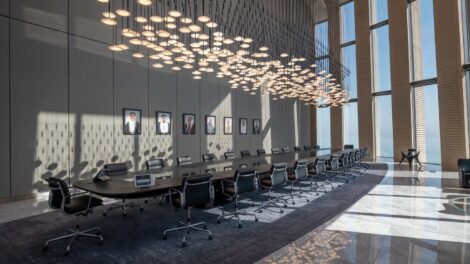
In today’s knowledge era, it seems that meeting space standards change according to the most creative people who, so the experts say, work best in teams. It should therefore be a priority that the place where the most important company decisions are made, helps to nurture creativity, problem solving (whether small, medium or large), becomes the nerve centre of innovation.
Meeting rooms have become forums for creativity, equipped with everything you need to make sparks fly.

Things like flexibility, security, privacy, adaptability and maximization are just as important as creating a good design that lets users feel that it’s their own. We must create unique and stimulating spaces that encourage users to be present, to participate, to innovate, to make the best decisions, and to contribute ideas that make businesses grow. Lastly, we aim to achieve profitability, even if it means tightening the purse strings a little at first.
Create inspirational spaces: Designing spaces that inspire creativity and innovation is crucial to encourage active employee participation. Spaces that stimulate creativity can encourage great ideas and problem solving. So the meeting room should engage users, make them want to be there, and provide everything they need to present ideas and create discussions. The company has a tremendous chance to communicate its corporate values.
And in the business world, corporate identity is a key element for any company’s success. The way we present ourselves and communicate with our customers and partners can make a huge difference in how we are viewed in the marketplace. And while we usually associate corporate identity with things like logos, colors and fonts, there is another element that is often overlooked: the meeting room. It is in the meeting room where ideas are generated, and important decisions are made. So that’s why it’s essential that the space reflects the image and values of the company in a coherent and professional way.
Flexibility: Flexible meeting space designing means easier adaptation for the ever changing requirements of users, and word dynamics. By using modular and mobile tables means the room can be easily rearranged to suit different meeting formats. This gives greater versatility and creativity in the space’s layout. In addition, retractable technology integration like monitors, microphones, cameras and loudspeakers, help make the meeting table comfortable, versatile and for multiple work formats.
Participation and collaboration: Encouraging participation and collaboration is fundamental to maximizing the team’s collective potential. By being able to adapt to new working ways and technologies is vital in the knowledge era of today. That’s why meeting spaces must be equipped for users to connect their mobile devices, and enable hybrid working.
Cost-efficiency and sustainability: The pursuit of cost-efficiency requires a balance between efficiency and an investment in technology that enhances productivity, creativity, that ultimately assists with decision-making and employee comfort and satisfaction. Using technology that is durable, designed to last and made of sustainable materials is a safe bet. And if the technology also helps with the space’s flexibility, it will undoubtedly make it versatile for differents uses, thus maximizing the return on investment.
In conclusion, a meeting room design must take into consideration a combination of physical, technological, and cultural factors that will create an enviroment to encourage innovation, creativity, collaboration and efficiency. This way meeting rooms will be inspiring environments that encourage the exchange of ideas, easy connection for all device types and remote teams, which ignites the creative spark, and where ideas can flourish.



